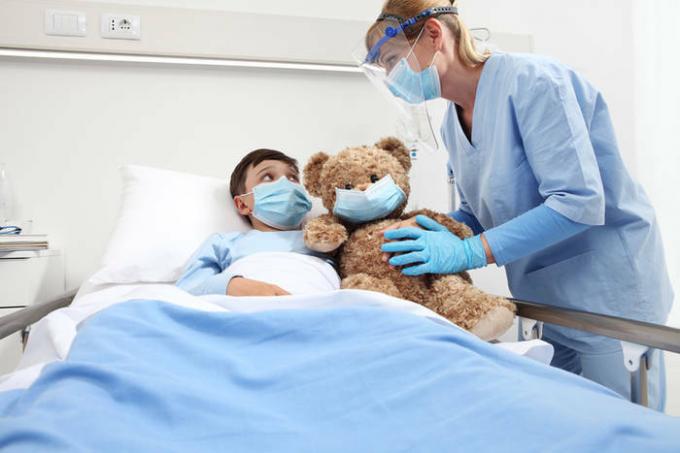In the United States, an increase in mortality after coronavirus in children is recorded. The reason is a complication called multisymptomatic syndrome. How do you recognize it? Infectious disease response
The Delta coronavirus is rampant in the world: according to the WHO, now this strain has already ousted all its fellows. In addition to its incredible infectiousness, it is also dangerous because it causes a lot of complications. Recently, the WHO published a whole bunch of health problems characteristic of postcoid syndrome. At the same time, a new attack is being reported in America, which children are more susceptible to than others. Against the background of the "Delta", there has not only jumped the level of morbidity among schoolchildren: in many children, after illness, a multisymptomatic (it is also called Kawasaki-like) syndrome manifests itself.
What is multisymptomatic syndrome

Multisymptomatic syndrome most often affects children 6-11 years old / istockphoto.com
According to the US Centers for Disease Control and Prevention (CDC), the incidence of covid among children has skyrocketed in the country since early fall. The reasons are simple: firstly, children went en masse to kindergartens and schools. Secondly, vaccination in the United States is allowed from the age of 12. Therefore, younger schoolchildren (from 6 to 11 years old) now suffer most from the disease. There is good news: for the most part, children still carry the infection more easily than adults. Bad news: Delta strain is more likely to develop after MIS-C disease or multisymptomatic inflammatory syndrome.
This is one of the complications of coronavirus, which usually manifests itself 3-4 weeks after infection (and there is evidence that it can develop even after an asymptomatic course of the disease). Most often it is diagnosed in children, so the syndrome is usually added to the "pediatric" (in adults, this condition is less common and is called MIS-A). Last year, British doctors recognized MIS-C as a separate immune pathology. However, it is obvious that it develops as a result of the transferred COVID-19.
Multisymptomatic syndrome is a serious inflammatory process that affects several body systems at once. The lungs, heart, kidneys, skin and brain are usually affected. Sometimes MIS-C causes oxygen deprivation, and many have liver damage. In severe stages of the inflammatory process, the failure of damaged organs is possible, which leads to death. It is possible to recover, but only with the timely intervention of doctors: MIS-C is not treated at home, children with this syndrome are hospitalized in a hospital.
How to recognize MIS-C in a child in time

Treatment of multisymptomatic syndrome is necessary only in a hospital / istockphoto.com
In the United States, more than 5 thousand have already been confirmed in the last month. diagnoses of multisymptomatic syndrome in children. At the same time, data from the CDC indicate that the number of daily cases of the disease has doubled. In Ukraine, there is still no similar summary information, however, doctors warn that MIS-C affects children in our country.
The main task of parents is not to miss the manifestation of multisymptomatic syndrome in a child. They are usually similar to Kawasaki disease, which is why MIS-C is also called Kawasaki-like syndrome. What it looks like, and what red flags should be a signal that it is time for the child to go to the hospital, the infectious disease doctor said Evgeny Shcherbina.
- fever for more than 5 days, which is accompanied by a steady increase in temperature over 38 degrees, while the temperature does not go well;
- inflammation of the mucous membrane of the eye: the so-called "dry" conjunctivitis, without pus, with redness of the eyes and painful sensations;
- an increase in lymph nodes under the lower jaw (most often it is unilateral, but there is also bilateral lymphadenitis);
- inflammation of the oral mucosa: severe redness, which is noticeable even with the naked eye, sometimes a "raspberry tongue" is noted, as in scarlet fever;
- a rash on the body: it can be localized in different places, does not go away for several days, most often looks like small flat or convex blisters, looks like a measles rash (exanthema);
- sometimes there is redness of the palms with slight peeling of the skin, while the hands are usually swollen;
- stomach pain accompanied by nausea, diarrhea, or vomiting;
- chest pain and pressure, shortness of breath.
If you notice several of the above symptoms in your child, urgently contact your doctor and be sure to tell him about your suspicions of MIS-C. Especially if a child or one of your family members has recently had a coronavirus. This is necessary in order to exclude other diseases (the same measles or scarlet fever) and to start timely treatment. Multisymptomatic syndrome is treated in a completely different way from other infectious diseases: immunoglobulins, anticoagulants, anti-inflammatory drugs are needed here. Any delay in this case is fraught with damage to internal organs, so you should not refuse hospitalization.
You will also be interested to read:
How to protect children from the Delta strain: advises Dr. Komarovsky
Hearing loss and blood clots: the Ministry of Health named the main symptoms of the Delta strain

